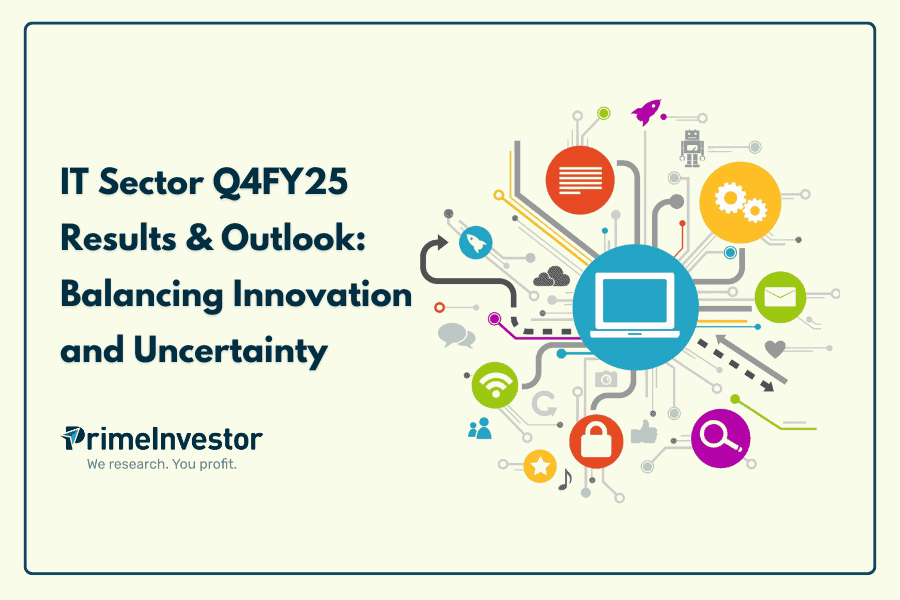After two challenging years, the Indian IT sector appeared poised for recovery in FY26. Anticipated US Federal Reserve rate cuts and the expected revival in discretionary spending were predicted to provide strong tailwinds. A surge in large deal wins during the second half of FY25 further bolstered investor confidence in IT stocks.

However, this optimism proved short-lived. President Trump’s implementation of reciprocal tariffs disrupted US markets and heightened recession concerns, creating uncertainty for Indian IT companies through potential second-order effects on their clients in key international markets.
Rather than relying on market narratives, we’ve analyzed the actual performance data to assess the sector’s trajectory. Our examination of Q4 FY25 and full-year FY25 results from leading IT companies provides insights into what lies ahead.
Note: This analysis focuses on top large-cap IT companies and the two leading mid-cap ER&D firms to evaluate the sector’s earnings performance and outlook.
Q4FY25 earnings
The Q4 FY25 earnings season was a mixed bag with revenues meeting expectations but margins disappointing.
Here is a quick glance into Q4FY25 performance of top IT companies:
If we exclude the impact of one-off income in Q4FY24, Infosys delivered 7-10% PAT growth in Q4FY25. LTTS however was hit by operational weakness.
In this quarter, revenue growth for IT majors was led by three verticals; Banking, Financial Services & Insurance (BFSI), Manufacturing, and Energy & Utilities.
- TCS dominated the BFSI vertical through legacy modernization and cost optimization initiatives. Their Ignio AI platform now powers 80% of SaaS customers, with AI integrated into 33% of all client engagements. The company posted strong growth in BFSI (12.6%), Manufacturing (14%), and Energy & Utilities.
- HCLTech excelled in Manufacturing due to robust ER&S deals (up 75% in FY25). Their Telecom & Media segment grew 43.4% following the strategic acquisition of HP’s CTG assets in December 2024.
- LTIMindtree focused on sales transformation and vendor consolidation opportunities. Q4 featured strong TCV bookings with industrial clients representing half of all new business.
- Persistent Systems achieved 54% growth in Healthcare & Life Sciences, but faces potential headwinds from reduced U.S. public spending in technology and services.
While BFSI, Manufacturing, and Energy & Utilities provided crucial momentum, other verticals lagged. The retail sector continued to see delays in spending due to weak consumer sentiment, particularly since February, after Trump tariffs were imposed.
Full year earnings
For the full year FY25, large firms delivered single digit revenue and profit growth while mid-sized firms delivered double digit growth, with Persistent leading the pack. For LTTS, margin performance was hit by acquisitions and investments towards restructuring of its business verticals.
Here is a snapshot of the FY25 performance of top IT companies:
Earnings takeaway
A key positive takeaway from Q4FY25 and the whole of FY25 would be that the deal wins for companies remained strong across the board despite a constrained spending environment and many of the mid-cap IT companies beat their own best in terms of the size of deals they won.
While deal values have been healthy, they have not translated to revenue at the required pace. This has been one of the reasons for margin pressure. The other reasons can be summed up as under:
- Employee compensation increases: Companies like Infosys cited wage hikes effective January, which had a significant negative impact on margins-Infosys reported a 140-basis point hit from pay increases alone.
- Rising operating costs: Additional costs such as amortization of recent acquisitions, marketing, and promotions further weighed on margins for major players like TCS and Infosys.
- Weak revenue growth and pricing pressure: The global economic slowdown led to subdued client spending and pricing competition, resulting in lower revenue growth and limited operating leverage.
- Delayed realization from new deals: Many new contracts are focused on cost reduction and vendor consolidation, which come with lower margins and delayed profit realization
Business Takeaway: Gen-AI Drives IT Deal Transformation
Understanding Generative AI: The Basics
Generative AI is like a super-smart digital assistant that can create new content after learning from massive amounts of data. Unlike traditional software that follows strict rules, generative AI can:
- Write text (like emails, reports, or stories)
- Create images from descriptions
- Generate code for software
- Translate languages naturally
- Answer questions using knowledge it’s learned
It works by recognizing patterns in the data it was trained on and then producing original content that follows those patterns.
How Companies Can Tap Into Generative AI
Customer Service
- Deploy AI chatbots that handle routine questions 24/7
- Generate personalized responses to customer inquiries
- Summarize customer feedback into actionable insights
Content Creation
- Produce first drafts of marketing materials, product descriptions, and reports
- Generate images for websites and presentations
- Create multiple versions of content for different audiences
Product Development
- Brainstorm new product ideas and features
- Generate code to accelerate software development
- Design product prototypes quickly
Operations
- Automate data entry and document processing
- Create and analyze financial reports
- Optimize workflows by identifying inefficiencies
Employee Productivity
- Draft emails and internal communications
- Summarize lengthy documents and meetings
- Provide research assistance on any topic
The key to success in using Gen AI lies in starting with specific problems a business needs to solve, rather than implementing the technology for its own sake.
Source: various AI tools
Generative AI (Gen AI) may well be emerging as the critical differentiator in India’s IT sector, transforming how deals are structured, executed, and priced. As IT companies navigate economic uncertainties, GenAI is simultaneously creating new opportunities and reshaping traditional business models for major IT services providers. Let’s see how this is transpiring:
- AI/GenAI as a common thread: AI, especially GenAI, is now central to nearly every large IT deal. Companies like TCS, Infosys, HCLTech, LTIMindtree, and Wipro are integrating AI-driven solutions for cost optimization and digital transformation, with AI-led deal wins highlighted in their Q4 FY25 results. LTIMindtree’s CEO specifically noted a “deepening adoption of AI across our portfolio of services,” and HCLTech reported 12 new AI- and automation-related contracts in the quarter.
- Bundled cost efficiency and transformation: Clients are prioritizing cost efficiency, digital transformation, and vendor consolidation, with bundled AI solutions now becoming standard in large deals.
- Deal structures and margins: GenAI is driving clients to demand more value at lower costs, often shrinking overall deal sizes while maintaining unit pricing. This is leading to a decoupling of headcount from revenue growth, as AI boosts productivity and reduces the need for manual effort.
- Margin retention uncertainty: While AI-driven productivity gains are helping protect margins, there is uncertainty about how much of these gains IT firms will retain versus pass on to clients through price reductions.
- Sector-wide trends: All major IT firms are seeing robust AI deal pipelines and are focusing on cost optimization, vendor consolidation, and enhanced customer experience, particularly in BFSI and manufacturing.
Generative AI (GenAI) has rapidly become the backbone of large IT deals in India, with TCS, Infosys, HCLTech, LTIMindtree, and Wipro all reporting that AI-driven modernization is now integral to nearly every major contract. Clients are increasingly seeking bundled solutions that combine cost efficiency, digital transformation, and AI-led productivity, making these features the new industry standard.
This shift is reshaping deal structures: while per-unit pricing remains stable, overall deal sizes are shrinking as clients expect the same output with fewer resources, thanks to GenAI’s productivity gains. As a result, the traditional link between headcount and revenue growth is fading, with IT firms leveraging AI to deliver more with less.
FY26 Outlook for IT companies
Guidance from IT majors reflected cautious optimism, underpinned by a robust deal pipeline, ongoing AI-driven transformation, and a gradual revival in key verticals.
- Revenue Growth: Large-cap IT companies are likely to experience negative to flat revenues in FY26, with guidance generally in the range of 0 to 5% range. In contrast, mid-cap IT and ER&D firms are expected to post high single-digit to double-digit growth, benefitting from faster deal conversion and less exposure to delayed mega-projects.
- Trends in sector-wise orders: A strong order backlog and expectations of a rebound in discretionary spending, especially in the BFSI (Banking, Financial Services, Insurance) sector which is not a direct victim of tariffs, provide a foundation for this optimism amid uncertainties. BFSI has shown a healthy recovery and is expected to lead sector growth. While largely unaffected by tariffs so far compared to other sectors, BFSI may still experience a second-order impact if the high tariffs remain, leading to a US or global slowdown. Media & Communications continues to see strong deal traction, and Energy & Utilities maintains a robust pipeline.
- Headwinds: Manufacturing, retail, mobility, and aerospace face uncertainties from tariffs and global macro risks, while healthcare may slow due to reduced US public spending.
- Margins: Margin expansion initiatives-such as Infosys’s Project Maximus and LTIMindtree’s Fit4Future-are leveraging GenAI and automation to reduce manpower costs and improve operational efficiency. EBIDTA Margins are projected to stabilize in the 20-22% range for most large players, with a 100-120 basis point expansion possible as cost pressures ease and AI-led efficiencies gain scale.
- Hiring and Attrition: Hiring will remain subdued, and attrition rates are stabilizing at lower levels as growth slows and prior hiring meets current demand
Overall the sector anticipates a slow start to FY26, with growth momentum expected to pick up only after Q2, particularly for large caps. Meanwhile, mid-cap IT firms are set for a stronger start, leveraging their agility and AI-led offerings to capture emerging opportunities.
Valuations
Before commenting on valuations, let’s take a quick glimpse into growth rates. Below is the revenue and profit growth of IT companies for the last year as well as for the last 3 years between FY23 to FY25
The earnings slowdown that began in H2 FY23 persisted through FY25. Expected recovery in FY26 (driven by US Fed rate cuts and discretionary spending revival) was derailed by tariff uncertainties, sending the Nifty IT Index down 30% in early 2025.
The PE ratios that started to look up on expectations of growth revival in FY26 also took a plunge.
Current Valuations
- Large IT firms: Trading at 20-25x PE, supported by ~5% free cash flow yield. This may prevent valuations from moderating further despite growth concerns.
- Mid-cap IT: Trading at 25-35x PE (except outliers like Persistent), reflecting their double-digit growth and stronger guidance.
Despite two key uncertainties—potential second-order effects from US tariffs and Gen-AI’s impact on profitability – valuations appear reasonable across both segments.
Several recommended IT stocks (both large and mid-cap) are available in our list of recommended stocks Prime Stocks.




4 thoughts on “IT Sector Q4FY25 Results & Outlook: Balancing Innovation and Uncertainty”
Thank you for the detailed note. Can you please explain the thought process behind the point that “the FCF yield of 5% is likely to prevent further valuation erosion”.
Hi sir, Generally in a market environment where growth is uncertain with increased margin pressures the presence of a solid FCF yield acts as a valuation floor, Because even with muted earnings a good FCF yield will allow the company to be self sufficient and can continue to pay dividends or invest in growth without external financing this will support investors confidence and prevent valuation de-rating.
Thanks,
Sudharsan.
Comprehensive article with good analysis.
Any short term/ long term impact to Indian IT industry due to increasing GCC – Global Capability Centers?
Hi sir, GCCs are shifting from handling simple, routine IT tasks to managing much more advanced product development and services. This requires upskilling their employees and hiring people with advanced skills. It also leads to collaboration with Indian IT firms to co-develop products and solutions, which benefits Indian IT firms by giving them access to new technologies and global clients.
To put it simply, GCCs are no longer just cost-cutting centers; they are becoming innovation hubs, which will benefit Indian IT firms in the long run.
Thanks,
Sudharsan
Comments are closed.